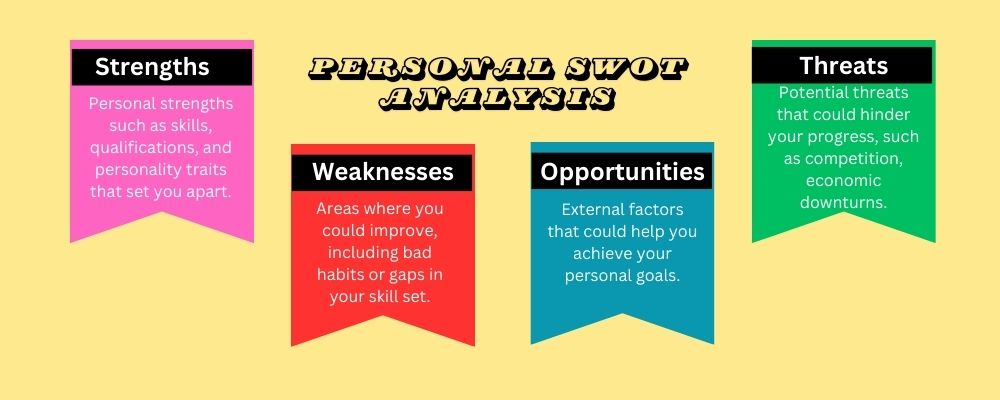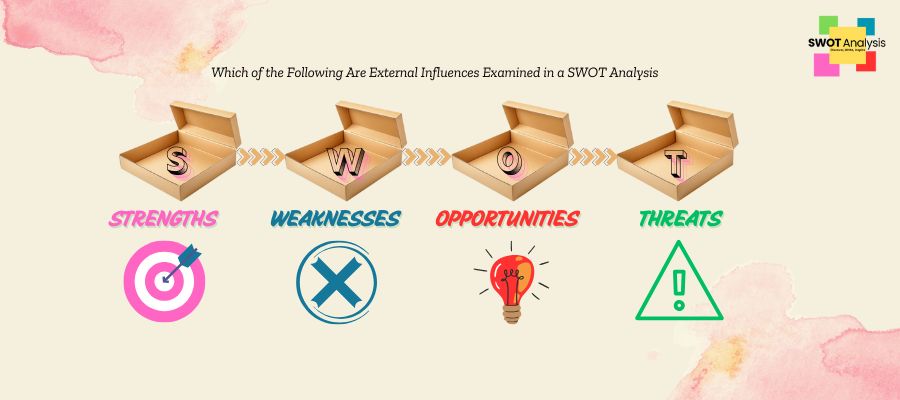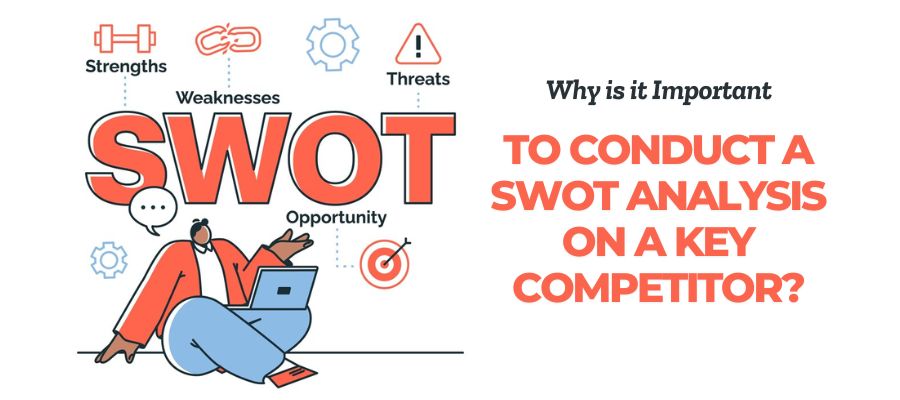In the journey of personal growth and development, understanding your strengths, weaknesses, opportunities, and threats can be incredibly valuable. This is where a Personal SWOT Analysis comes into play. Originally a tool for businesses, SWOT analysis has been adapted for personal use, allowing individuals to achieve personal and professional goals.
In this article, we’ll explore how a personal SWOT analysis can help you set and achieve your goals, and why it’s an essential tool for strategic planning in your personal life. By the end of this guide, you’ll not only know how to conduct a personal SWOT analysis but also understand how it can set you apart from others in your career and personal pursuits.
Personal SWOT Analysis Template and Alternative Activities
Before diving into the process, it’s helpful to know that there are multiple ways to approach a personal SWOT analysis. While the traditional method involves a SWOT analysis template, some prefer alternative activities like journaling, mind mapping, or using digital tools to visualize their strengths and weaknesses.
Here’s a simple SWOT diagram template:
| Strengths | Weaknesses |
| Opportunities | Threats |
This matrix helps you break down your internal and external factors, providing clarity on the areas you can leverage and the challenges you may need to address.
Understanding Personal SWOT Analysis
Explanation of SWOT (Strengths, Weaknesses, Opportunities, Threats)
SWOT stands for Strengths, Weaknesses, Opportunities, and Threats. Each component plays a critical role:
- Strengths: Personal strengths such as skills, qualifications, and personality traits that set you apart.
- Weaknesses: Areas where you could improve, including bad habits or gaps in your skill set.
- Opportunities: External factors that could help you achieve your personal goals, like market trends or potential career growth avenues.
- Threats: Potential threats that could hinder your progress, such as competition, economic downturns, or negative influences.
Relevance of SWOT Analysis in Personal Development
Conducting a SWOT analysis is a self-assessment tool that offers valuable insights based on your personality, helping you understand your strengths and areas you could improve. It’s especially relevant for those looking for personal growth, as it helps you focus on the opportunities and threats in your environment. Whether you want a new job, are aiming for a promotion, or are working on self-improvement, a SWOT analysis can help you figure out the best career path forward.
How It Differs from Traditional SWOT Analysis in Business
While a business SWOT analysis focuses on market conditions, competition, and strategic planning, a personal SWOT analysis is more introspective. It’s about understanding yourself better to achieve your goals. However, the core principles remain the same: analyze your strengths, identify threats, and capitalize on opportunities.
How to Create a Personal SWOT Analysis
Step-by-Step Guide to Conducting a Personal SWOT Analysis
- List Your Strengths: Start by listing your strengths, such as strong communication skills, a diverse skill set, or a particular qualification that can set you apart from others. Think about areas where you excel and traits that help you succeed.
- Identify Weaknesses: Next, honestly assess your weaknesses. This could include specific skills you lack, bad habits, or areas where you’ve received negative feedback. The goal isn’t to feel bad about these weaknesses but to understand them so you can work on improvement.
- Explore Opportunities: In the opportunities section, list external factors that could help you reach your personal goals. This might include trends in your industry, networking opportunities, or a job interview for a role you’ve been eyeing.
- Assess Threats: Finally, consider external factors that could hinder your progress. Threats can also include competition, economic factors, or personal obstacles that might stand in your way.
- Create an Action Plan: Use your SWOT analysis to form an action plan. Focus on leveraging your strengths, addressing your weaknesses, capitalizing on opportunities, and mitigating threats.
Tools and Resources for Effective Analysis
To conduct the analysis, you can use various tools like SWOT analysis templates available online, digital apps, or even traditional pen and paper. Resources like books on personal development, career counseling, and certification courses can also help you gain insights and improve your skills.
Personal SWOT Analysis Examples
Here are some personal SWOT analysis examples to illustrate how this tool can be applied in different contexts:
- Career Advancement:
- Strengths: Strong leadership skills, and certification in project management.
- Weaknesses: Lack of experience in digital marketing.
- Opportunities: Upcoming training programs, a leadership position opening in your company.
- Threats: Competition from colleagues with more digital experience.
- Personal Development:
- Strengths: Good at time management, and ability to relocate.
- Weaknesses: Poor work-life balance.
- Opportunities: Flexible working hours, and access to wellness programs.
- Threats: Risk of burnout, family obligations.
Personal SWOT Analysis for Students
For students, a personal SWOT analysis can be incredibly helpful in academic and career planning. Here’s how:
- Strengths: Strong academic performance, and good networking skills.
- Weaknesses: Procrastination, lack of internship experience.
- Opportunities: Internship opportunities, career fairs, scholarships.
- Threats: High competition, and potential financial constraints.
By understanding these factors, students can better prepare for the challenges ahead and make strategic decisions that align with their career goals.
How to Conduct a Personal SWOT Analysis
Performing a personal SWOT analysis involves reflecting on your life, goals, and the environment around you. It’s a process of self-discovery that can lead to significant personal and professional growth. Consider the following steps:
- Start with introspective questions: Ask yourself about your strengths, weaknesses, opportunities, and threats.
- Seek feedback: Sometimes, people in your life can offer insights that you may not have considered.
- Regularly update your SWOT: As you grow and your environment changes, your SWOT analysis should evolve.
Benefits of Conducting a Personal SWOT Analysis
Conducting a Personal SWOT Analysis provides a range of significant benefits that can profoundly impact both your personal and professional life:
- Clarity: A personal SWOT analysis helps you understand your strengths and weaknesses with greater precision. By listing your core competencies and areas that need improvement, you gain a clearer picture of where you stand, allowing for more informed decision-making.
- Focus: The process allows you to identify opportunities and threats that might influence your progress. By focusing on these external factors, you can prioritize your efforts on the most impactful areas, whether you’re planning a career move or working on personal development.
- Actionable Insights: A SWOT analysis offers actionable insights by revealing what steps you should take next. This clear roadmap helps you create targeted strategies for growth, whether in your career, education, or personal life.
- Strategic Planning: By aligning your traits or skills with current market demands or personal goals, a SWOT analysis aids in strategic planning. It allows you to maximize your strengths while mitigating any potential weaknesses, ensuring you’re well-prepared for future challenges.
- Empowerment: Perhaps one of the most empowering aspects of a personal SWOT analysis is its ability to put you in control of your future. By understanding both your internal and external factors, you can take proactive steps toward achieving your goals, whether that’s advancing in your career, improving your personal relationships, or embarking on new ventures.
Overall, a SWOT analysis equips you with the knowledge and confidence to make informed decisions and take deliberate actions that set you apart in both your professional and personal life.
Business SWOT Analysis Versus Personal SWOT Analysis
While both business and personal SWOT analyses follow the same framework, they serve different purposes. A business SWOT analysis is about market positioning and strategic planning, while a personal SWOT analysis is a self-assessment tool aimed at personal growth and achieving your goals.
Conclusion
In conclusion, using a personal SWOT analysis can be a powerful way to understand your strengths, weaknesses, opportunities, and threats. By conducting this analysis regularly, you can stay on top of your personal and professional development, ensuring that you’re always moving forward toward your goals.
FAQs
What is a personal SWOT analysis and examples?
A personal SWOT analysis is a self-assessment tool that helps individuals understand their strengths, weaknesses, opportunities, and threats. Examples include analyzing your skills for career advancement or evaluating personal traits for self-improvement.
Why is personal SWOT analysis important?
It’s important because it helps you gain clarity on your current position, identify areas for improvement, and create a strategic plan for achieving your personal and professional goals.
When Should You Conduct a Personal SWOT Analysis?
It’s ideal to conduct a personal SWOT analysis when you’re planning significant changes in your life, such as pursuing a new job, setting career goals, or when you’re looking for personal growth.
What are some examples of personal SWOT?
Examples include identifying strengths like strong communication skills, weaknesses like poor time management, opportunities like new job openings, and threats like high competition.
How to write a SWOT analysis on yourself?
Start by listing your strengths, weaknesses, opportunities, and threats. Use a SWOT diagram or template to organize your thoughts, and reflect on how each element affects your personal and professional goals.
What is SWOT for personal development?
SWOT for personal development involves using the SWOT framework to assess your abilities, identify growth opportunities, and mitigate potential challenges to achieve your goals.
What are quick guide questions to identify strengths and opportunities?
Quick guide questions help you understand your strengths and opportunities by focusing on key traits or skills that set you apart. Some questions to ask include:
- What are my core strengths that match my strengths to my goals?
- What external factors could present new opportunities?
- What skills do I possess that outweigh the weaknesses I may have?
These questions help you identify areas where your strengths can be leveraged for personal or professional growth.
How does SWOT analysis help you understand weaknesses and threats?
A SWOT analysis helps you understand weaknesses and threats by allowing you to systematically assess the external factors that could impact your progress. For example, a free SWOT template can help you form a clear picture of where potential challenges may arise. SWOT analysis may reveal weaknesses in specific areas of your life and guide you in developing ways to improve. It also helps you think about external threats that could hinder your success, enabling you to take appropriate next steps.
What analysis questions help form a list of opportunities?
Analysis questions are critical for forming a list of opportunities that align with your goals. Questions to ask include:
- What are the next steps I should take to capitalize on market trends?
- How can I use my traits or skills to create new opportunities?
- What external factors could help you identify untapped opportunities?
These questions help you draw a box around potential opportunities that match your strengths and position you for personal or professional success. This type of analysis can help you understand how to leverage your strengths in new and effective ways.
Also Read: HellCage





